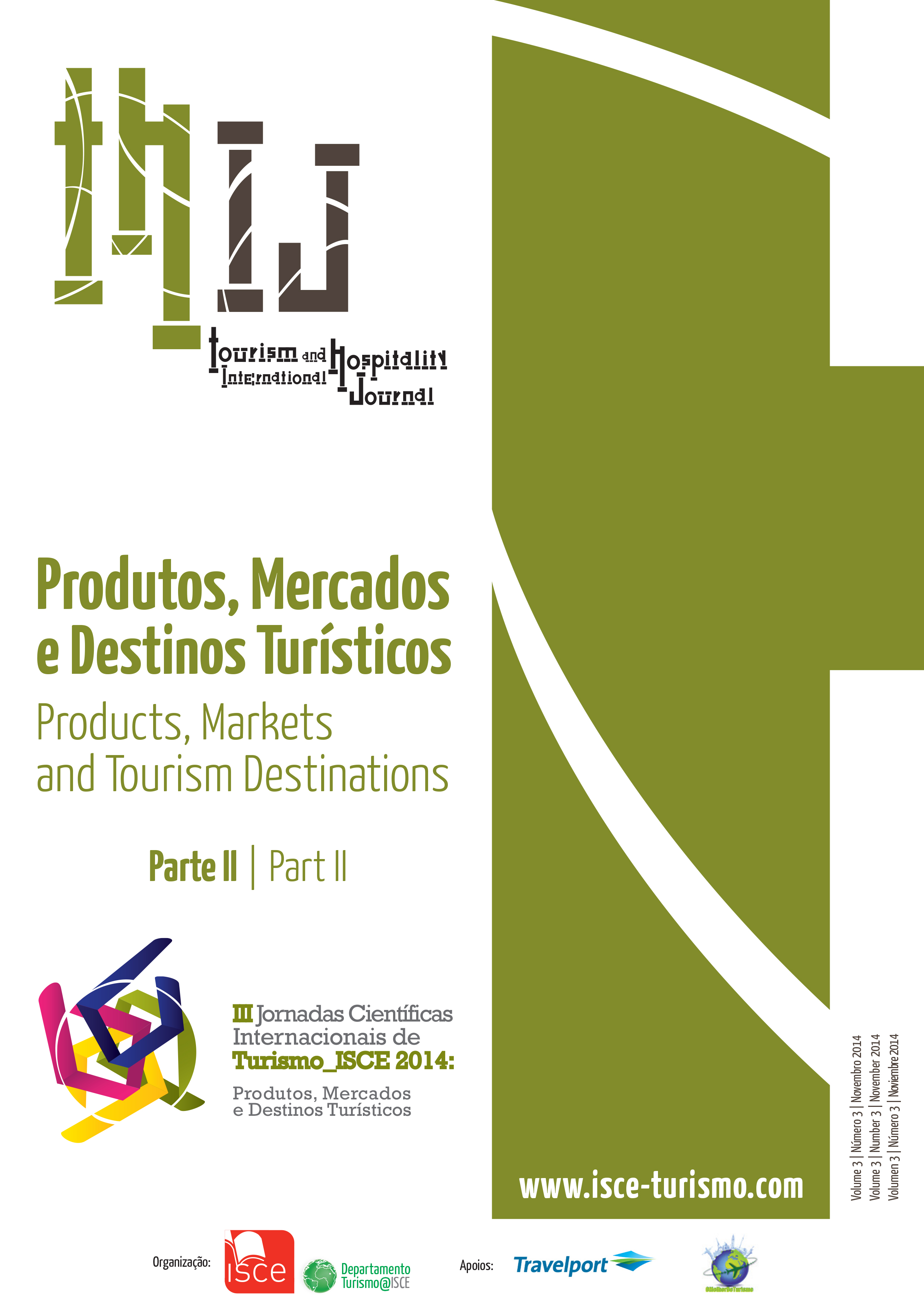O acesso dos deficientes visuais à cultura: Um estudo nos museus da cidade de Pirenópolis - Goiás
DOI:
https://doi.org/10.57883/thij3(2)2014.30151Palavras-chave:
Turismo responsável, Acessibilidade, Pirenópolis, Deficiência VisualResumo
O presente trabalho tem como objetivo analisar o acesso à cultura dos deficientes visuais, quais ações e propostas são desenvolvidas para a inclusão deste público específico nos museus de Pirenópolis – Goiás. O censo realizado em 2010 indicou que aproximadamente 45,6 milhões de pessoas, ou 23,9% da população apresentaram algum tipo de incapacidade ou deficiência e que deste percentual, uma expressiva parcela, cerca de 36 milhões, se declaram deficientes visuais. Os deficientes visuais podem estar sendo excluídos do direito de usufruir os atrativos turísticos e os meios culturais pela falta de consciências dos gestores do trade turístico. Os museus, por exemplo, devem possuir uma estrutura específica para melhor atendê-los, pois a interação dos deficientes visuais é realizada por meio do tato e informações auditivas. O recorte proposto foi no museu de Arte Sacra, localizado no município goiano. A pesquisa foi bibliográfica com análise de autores que abordam o tema. Foram realizadas entrevistas qualitativas e o registro fotográfico para verificar qual a atual situação do museu de Arte Sacra do município de Pirenópolis. A pesquisa de campo foi realizada em abril de 2014, onde se verificou que os museus da cidade são impróprios para a inclusão dos deficientes visuais, desde informações em braile, recursos auditivos e pisos específicos para guiá-los no interior do mesmo. Sugere-se o desenvolvimento de estratégia de sensibilização dos responsáveis pelos setores públicos bem como dos curadores deste museu em especifico na cidade de Pirenópolis – GO.
Referências
Borda, G. Z. ; Duarte, D. C.; Serpa, A. B. (2013). Tourism for all: accessibility and social inclusion in Brazil the case of Socorro (São Paulo estate) tourism destination. In: International Critical Tourism Studies Conference. (pp.1-17). Saravejo, Bosnia e Herzegovina,.
Cohen, R.; Duarte, C. e Brasileiro, A. (2012). Acessibilidade a Museus Ministério da Cultura/Instituto Brasileiro de Museu. – Brasília, DF
Coordenadoria Nacional para Integração da Pessoa Portadora de Deficiência. (2005). Acessibilidade. In: Niusarete Margarida de Lima. Brasilia: Secretaria Especial dos Direitos Humanos
Duarte, D. C. (2005). Metodologia para desenvolvimento de portais de relacionamento para comunidades de prática: uma aplicação para área do turismo e pessoas com necessidades especiais. Departamento de Engenharia de Produção, Universidade Federal de Santa Catarina.
Duarte, D. C.; Borda, G. Z. (2012). Turismo sênior em Brasília: um estudo sobre a acessibillidade e sustentabilidade no setor hoteleiro. In: XVII Congresso Internacional AECIT 2012, O Carballiño. XVII Congresso Internacional AECIT 2012. Ourense: AECIT Asociasón Española de Expertos Científicos en Turismo, 2012. v. 17. p. 670-676.
Fialho, Manuela (2009). Rotas sem Barreiras. In: RevistaTurismo & Desenvolvimento. Journal of Tourism and Development. N. 11, p. 109-112.
Instituto Brasileiro De Geografia e Estatística - (IBGE) (2010). Censo Demográfico 2010: Resultados Preliminares da Amostra. Disponível em[http://www.ibge.gov.br/home/estatistica/populacao/censo2010/resultados_preliminares_amostra/default_resultados_preliminares_amostra.shtm]. Acesso em: 12 dez. 2013.
Garcia Cancline, Néstor. “O patrimônio cultural e a construção imaginária da nação”. In: Revista do IPHAN, nº 23, Cidade (org. Heloisa Buarque de Holanda), 2004. p. 96.
Mesquita, Susana & Carneiro, Maria. A acessibilidade à interpretação para deficientes visuais em museus de Lisboa. Revista Turismo & Desenvolvimento. N. 17/18, p. 1441 a 1452, 2012.
Ministério do Turismo. Turismo Acessível Bem Atender no Turismo Acessível, volume III. Brasília: Ministério do turismo, 2009.
Veja Quais são os 10 Museus mais visitados do mundo. http://viagem.br.msn.com/pureviagem/veja-quais-s%C3%A3o-os-10-museus-mais-visitados-do-mundo dia 08 de maio de 2014 as 16:40
Perez, D. e Velasco, D., 2003, Turismo acessível – Hacia um turismo para todos, comitê Espanol de Representantes de Personas com Discapacidade, CERMI.
Pirenópolis. A cidade. Disponível em: [http://www.pirenopolis.go.gov.br/a-cidade/] Acesso em: 15 nov. 2013.
Reis, E. R. (2010). Deficiência física e atividade turística: um contraponto entre a legislação e a realidade, Belo Horizonte-MG.
Downloads
Publicado
Como Citar
Edição
Secção
Licença
Direitos de Autor (c) 2023 This work is licensed under a Creative Commons - Attribution 4.0 International (CC BY 4.0)

Este trabalho encontra-se publicado com a Licença Internacional Creative Commons Atribuição 4.0.
Este trabalho encontra-se publicado com a Licença Internacional Creative Commons Atribuição 4.0.






